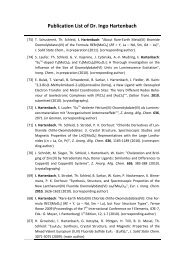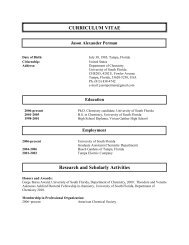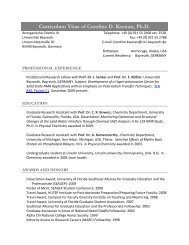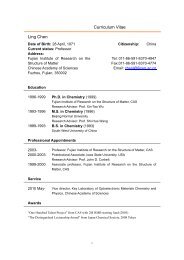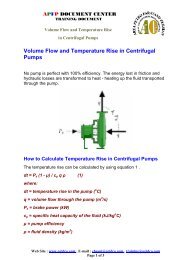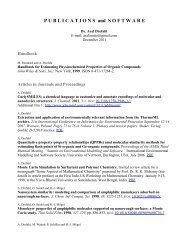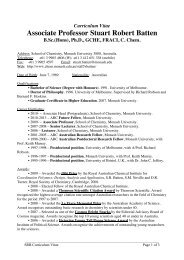Sports Drinks: Don't Sweat the Small Stuff - American Chemical ...
Sports Drinks: Don't Sweat the Small Stuff - American Chemical ...
Sports Drinks: Don't Sweat the Small Stuff - American Chemical ...
Create successful ePaper yourself
Turn your PDF publications into a flip-book with our unique Google optimized e-Paper software.
a polyurethane midsole with air pockets to<br />
give cushion and control. Ano<strong>the</strong>r shoe<br />
manufacturer, Fila, uses cells of air in a<br />
rubber-like polymer to provide <strong>the</strong> necessary<br />
cushioning. These cells are open, leaving<br />
<strong>the</strong>m unpressurized, so <strong>the</strong> air doesn’t<br />
escape if a cell is ruptured.<br />
More on midsoles<br />
Reebok goes a step fur<strong>the</strong>r by moving<br />
air through <strong>the</strong> chambers of <strong>the</strong> shoe.<br />
Before <strong>the</strong> heel comes down, <strong>the</strong> air chambers<br />
in <strong>the</strong> heel are filled with air. When <strong>the</strong><br />
heel hits, <strong>the</strong> air is forced into <strong>the</strong> chambers<br />
at <strong>the</strong> front of <strong>the</strong> foot. The ball of <strong>the</strong> foot’s<br />
weight forces <strong>the</strong> air back to <strong>the</strong> heel, and<br />
<strong>the</strong> shoe is ready for <strong>the</strong> next step. Some<br />
shoes, such as Converse’s All Stars, use a<br />
gel compound for shock absorption.<br />
To envision how <strong>the</strong> technology works,<br />
imagine a balloon full of air. When you push<br />
your hand down on <strong>the</strong> balloon, <strong>the</strong> air<br />
inside compresses slightly and cushions<br />
10 ChemMatters, FEBRUARY 1999<br />
your hand. Fill a balloon about half full of air<br />
and tie it. Pinch <strong>the</strong> air into one half of <strong>the</strong><br />
balloon. Holding <strong>the</strong> center loosely, squeeze<br />
<strong>the</strong> side with air. The air will be forced to <strong>the</strong><br />
o<strong>the</strong>r side of <strong>the</strong> balloon, like <strong>the</strong> airflow<br />
system in Reebok shoes.<br />
A different-looking shoe is <strong>the</strong> Nike<br />
Foamposite One. The upper and midsole are<br />
molded into one unit that is composed of<br />
polyurethane foam filled with air. This provides<br />
shock absorption as well as extra stability<br />
for <strong>the</strong> entire foot and ankle.<br />
Last step<br />
The shoe last is <strong>the</strong> form on which <strong>the</strong><br />
shoe is made. A board-lasted shoe contains<br />
Roberta Baxter is a freelance writer who lives in Colorado Springs, CO. Her article “Glass: An Amorphous<br />
Solid” appeared in <strong>the</strong> October 1998 issue of ChemMatters.<br />
REFERENCES<br />
Polymers<br />
The word polymer comes from two Greek words: poly, meaning many, and mer, meaning part. Polymer means a large<br />
molecule made of repeating parts. The repeating parts can be one molecule or a combination of two or more.<br />
Molecule(s) Polymer<br />
The characteristics of a polymer depend on its parts and <strong>the</strong> length of <strong>the</strong> molecule. For example, polyurethane can be made<br />
as a stiff material for protective paint coatings or as <strong>the</strong> soft foam used in basketball shoes.<br />
H 3C 3C C<br />
O<br />
O<br />
CH CH 2<br />
CH 2<br />
CH 2 CH CH 2 CH CH 2<br />
O<br />
C<br />
CH 3<br />
O<br />
Ordered condensation polymer as in polyurethane<br />
Random copolymer as in ethylene–vinyl acetate<br />
O<br />
C<br />
CH 3<br />
vinyl acetate ethylene–vinyl acetate polymer polyurethane<br />
The foams used in basketball shoes typically are ethylene–vinyl<br />
acetate or polyurethane. These substances become foams because of<br />
air that is whipped into <strong>the</strong>m. The structures are shown above.<br />
O<br />
O R O C<br />
CH 3<br />
NH C<br />
O<br />
O<br />
O<br />
urethane linkage<br />
Polyurethane foams are polymers of two repeating<br />
molecules, forming a urethane linkage. Different R<br />
parts (organic molecules) provide polyurethane with<br />
different characteristics.<br />
a fiberboard shape that is attached to <strong>the</strong><br />
upper, making a moderately stiff and stable<br />
shoe. For a flexible shoe, <strong>the</strong> last is slipped<br />
out of <strong>the</strong> shoe after <strong>the</strong> parts are stitched<br />
toge<strong>the</strong>r. Some shoes have a combination<br />
last: The last in <strong>the</strong> front is taken out after<br />
assembly, but <strong>the</strong> board in <strong>the</strong> heel remains<br />
in place.<br />
With time and use, though, <strong>the</strong> parts<br />
of <strong>the</strong> shoe wear out. The EVA or<br />
polyurethane foam will pack down and<br />
lose some of its cushioning character. The<br />
lea<strong>the</strong>r uppers begin to stretch with <strong>the</strong><br />
foot instead of supporting it. It’s important<br />
to replace worn-out shoes before you<br />
injure yourself.<br />
Bortz, A. B. Superstuff!: Materials That Have Changed Our Lives; Franklin Watts:<br />
New York, 1990.<br />
Slam-Dunking Hoop Shoes. Popular Mechanics, December 1997, p 47.<br />
NH



